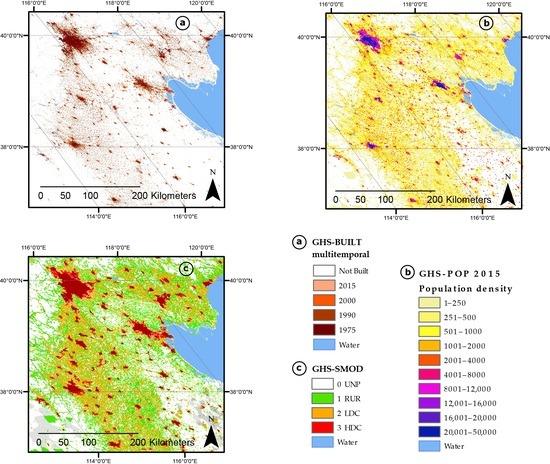Unveiling 25 Years of Planetary Urbanization with Remote Sensing: Perspectives from the Global Human Settlement Layer
Abstract
1. Introduction
2. Materials and Methods
- (a)
- The GHSL offers global coverage, and the possibility to aggregate data at multiple levels (from global and continental to subnational levels);
- (b)
- It is possible to observe the socio-spatial dimension of the urbanization process by capturing the demographics (population) and built-up areas;
- (c)
- The GHSL contains multi-temporal data for the epochs 1975–1990–2000–2015 to allow monitor human settlements and their process of change;
- (d)
- The application of the Degree of Urbanisation model [24] to the layer returns a globally consistent classification of human settlements, from which harmonized population and built-up statistics were generated.
3. Results
3.1. Spatial Expansion and Demographic Growth of Urban Areas
3.2. Planetary Reach of the Urbanization Process
- (A)
- The upper-left part shows where the degree of urbanization in 2015 was below the global average (85%) but the area had urbanized fast (the 1990–2015 degree of urbanization change was above the global average of 2.3%);
- (B)
- The lower-right part of the chart shows where the degree of urbanization in 2015 was above the global average but the urbanization process had been less vibrant (the change between 1990 and 2015 was below the global average);
- (C)
- In the upper right are countries that are more urbanized in 2015 and that since 1990 have urbanized faster than the global average;
- (D)
- In the lower left are those without a distinctive urban character and where the process of urbanization is not considerably relevant.
3.3. Concentration of People and Diffusion of Built-Up Areas
3.4. Urbanization and Agglomeration
3.5. Urban Growth and Pace of Urbanization
3.6. Uneven Aspects of Urbanization
4. Discussion
5. Conclusions
Supplementary Materials
Author Contributions
Acknowledgments
Conflicts of Interest
References
- Martine, G.; Marshall, A. State of world population 2007: Unleashing the potential of urban growth. In State of World Population 2007: Unleashing the Potential of Urban Growth; UNFPA: New York, NY, USA, 2007. [Google Scholar]
- United Nations Department of Economic and Social Affairs (UNDESA). World Urbanization Prospects the 2007 Revision; United Nations: San Francisco, CA, USA, 2008. [Google Scholar]
- Burdett, R.; Sudjic, D. (Eds.) The Endless City: The Urban Age Project by the London School of Economics and Deutsche Bank’s Alfred Herrhausen Society; Phaidon: London, UK, 2007. [Google Scholar]
- Davis, K. The Origin and Growth of Urbanization in the World. Am. J. Sociol. 1955, 60, 429–437. [Google Scholar] [CrossRef]
- Satterthwaite, D. Urban Myths and the Mis-Use of Data That Underpin Them; WIDER: Helsinki, Finland, 2010. [Google Scholar]
- G.A. United Nations. Transforming Our World: The 2030 Agenda for Sustainable Development; United Nations: San Francisco, CA, USA, 2015. [Google Scholar]
- Angel, S. Atlas of Urban Expansion; Lincoln Institute of Land Policy: Cambridge, MA, USA, 2012. [Google Scholar]
- Schneider, A.; Friedl, M.A.; Potere, D. A new map of global urban extent from MODIS satellite data. Environ. Res. Lett. 2009, 4, 044003. [Google Scholar] [CrossRef]
- Small, C. A global analysis of urban reflectance. Int. J. Remote Sens. 2005, 26, 661–681. [Google Scholar] [CrossRef]
- Schneider, A.; Friedl, M.A.; Potere, D. Mapping global urban areas using MODIS 500-m data: New methods and datasets based on ‘urban ecoregions’. Remote Sens. Environ. 2010, 114, 1733–1746. [Google Scholar] [CrossRef]
- Henderson, M.; Yeh, E.T.; Gong, P.; Elvidge, C.; Baugh, K. Validation of urban boundaries derived from global night-time satellite imagery. Int. J. Remote Sens. 2003, 24, 595–609. [Google Scholar] [CrossRef]
- Aune-Lundberg, L.; Strand, G.-H. Corine Land Cover 2006: The Norwegian CLC2006 Project; Norsk Institutt for Skog og Landskap: Ås, Norway, 2010. [Google Scholar]
- Ferri, S.; Syrris, V.; Florczyk, A.; Scavazzon, M.; Halkia, M.; Pesaresi, M. A new map of the European settlements by automatic classification of 2.5 m resolution SPOT data. In Proceedings of the 2014 IEEE Geoscience and Remote Sensing Symposium, Quebec City, QC, Canada, 13–18 July 2014; pp. 1160–1163. [Google Scholar]
- Gong, P.; Wang, J.; Yu, L.; Zhao, Y.; Zhao, Y.; Liang, L.; Niu, Z.; Huang, X.; Fu, H.; Liu, S.; et al. Finer resolution observation and monitoring of global land cover: First mapping results with Landsat TM and ETM+ data. Int. J. Remote Sens. 2013, 34, 2607–2654. [Google Scholar] [CrossRef]
- Manakos, I.; Braun, M. (Eds.) Land Use and Land Cover Mapping in Europe; Springer: Dordrecht, The Netherlands, 2014; Volume 18. [Google Scholar]
- Chen, J.; Chen, J.; Liao, A.; Cao, X.; Chen, L.; Chen, X.; He, C.; Han, G.; Peng, S.; Lu, M.; et al. Global land cover mapping at 30m resolution: A POK-based operational approach. ISPRS J. Photogramm. Remote Sens. 2015, 103, 7–27. [Google Scholar] [CrossRef]
- Esch, T.; Marconcini, M.; Felbier, A.; Roth, A.; Heldens, W.; Huber, M.; Schwinger, M.; Taubenböck, H.; Müller, A.; Dech, S. Urban Footprint Processor—Fully Automated Processing Chain Generating Settlement Masks From Global Data of the TanDEM-X Mission. IEEE Geosci. Remote Sens. Lett. 2013, 10, 1617–1621. [Google Scholar] [CrossRef]
- Roberts, M.; Blankespoor, B.; Deuskar, C.; Stewart, B. Urbanization and Development: Is Latin America and the Caribbean Different from the Rest of the World? The World Bank Group: Washington, DC, USA, 2017. [Google Scholar]
- Brenner, N.; Schmid, C. Towards a new epistemology of the urban? City 2015, 19, 151–182. [Google Scholar] [CrossRef]
- Montgomery, M.R. The Urban Transformation of the Developing World. Science 2008, 319, 761–764. [Google Scholar] [CrossRef] [PubMed]
- Center for International Earth Science Information Network-CIESIN-Columbia University. Gridded Population of the World, Version 4 (GPWv4): Population Density; Palisades, NASA Socioeconomic Data and Applications Center (SEDAC): New York, NY, USA, 2016. [Google Scholar]
- Balk, D.L.; Deichmann, U.; Yetman, G.; Pozzi, F.; Hay, S.I.; Nelson, A. Determining Global Population Distribution: Methods, Applications and Data. In Advances in Parasitology; Elsevier: New York, NY, USA, 2006; Volume 62, pp. 119–156. [Google Scholar]
- Tatem, A.J.; Noor, A.M.; von Hagen, C.; di Gregorio, A.; Hay, S.I. High Resolution Population Maps for Low Income Nations: Combining Land Cover and Census in East Africa. PLoS ONE 2007, 2, e1298. [Google Scholar] [CrossRef] [PubMed]
- Dijkstra, L.; Poelman, H. A Harmonised Definition of Cities and Rural Areas: The New Degree of Urbanisation; Publications Office of the European Union: Ispra, Italy, 2014. [Google Scholar]
- Brenner, N. Theses on Urbanization. Public Cult. 2013, 25, 85–114. [Google Scholar] [CrossRef]
- Brenner, N.; Schmid, C. The ‘urban age’ in question. Int. J. Urban Reg. Res. 2014, 38, 731–755. [Google Scholar] [CrossRef]
- Melchiorri, M.; Siragusa, A. Analyzing Cities with the Global Human Settlement Layer: A Methodology to Compare Urban Growth Using Remote Sensing Data. In Smart and Sustainable Planning for Cities and Regions; Bisello, A., Vettorato, D., Stephens, R., Elisei, P., Eds.; Springer: Cham, Switzerland, 2018. [Google Scholar] [CrossRef]
- Soja, E.W. Beyond Postmetropolis. Urban Geogr. 2011, 32, 451–469. [Google Scholar] [CrossRef]
- Pesaresi, M.; Melchiorri, M.; Siragusa, A.; Kemper, T. Atlas of the Human Planet 2016; EUR 28116 EN; Publications Office of the European Union: Ispra, Italy, 2016. [Google Scholar]
- Gutman, G.; Huang, C.; Chander, G.; Noojipady, P.; Masek, J. Assessment of the NASA-USGS Global Land Survey (GLS) datasets. Remote Sens. Environ. 2013, 134, 249–265. [Google Scholar] [CrossRef]
- Pesaresi, M.; Ehrlich, D.; Ferri, S.; Florczyk, A.; Freire, S.; Halkia, M.; Julea, A.; Kemper, T.; Soille, P.; Syrris, V. Operating Procedure for the Production of the Global Human Settlement Layer from Landsat Data of the Epochs 1975, 1990, 2000, and 2014; JRC Technical Report EUR 27741 EN; Publications Office of the European Union: Ispra, Italy, 2016. [Google Scholar]
- Pesaresi, M.; Syrris, V.; Julea, A. A New Method for Earth Observation Data Analytics Based on Symbolic Machine Learning. Remote Sens. 2016, 8, 399. [Google Scholar] [CrossRef]
- Pesaresi, M.; Huadong, G.; Blaes, X.; Ehrlich, D.; Ferri, S.; Gueguen, L.; Halkia, M.; Kauffmann, M.; Kemper, T.; Lu, L.; et al. A Global Human Settlement Layer from Optical HR/VHR RS Data: Concept and First Results. IEEE J. Sel. Top. Appl. Earth Obs. Remote Sens. 2013, 6, 2102–2131. [Google Scholar] [CrossRef]
- Arino, O.; Perez, J.J.R.; Kalogirou, V.; Bontemps, S.; Defourny, P.; van Bogaert, E. Global Land Cover Map for 2009 (GlobCover 2009); European Space Agency (ESA) & Université Catholique de Louvain (UCL): Frascati, Italy, 2012. [Google Scholar]
- Smith, D.A. Visualising world population density as an interactive multi-scale map using the global human settlement population layer. J. Maps 2017, 13, 117–123. [Google Scholar] [CrossRef]
- Pesaresi, M.; Ehrlich, D.; Florczyk, A.J.; Freire, S.; Julea, A.; Kemper, T.; Syrris, V. The global human settlement layer from landsat imagery. In Proceedings of the IEEE International Geoscience and Remote Sensing Symposium (IGARSS), Beijing, China, 10–15 July 2016; pp. 7276–7279. [Google Scholar]
- Freire, S.; MacManus, K.; Pesaresi, M.; Doxsey-Whitfield, E.; Mills, J. Development of New Open and Free Multi-Temporal Global Population Grids at 250 m Resolution; AGILE: Helsinki, Finland, 2016. [Google Scholar]
- Klotz, M.; Kemper, T.; Geiß, C.; Esch, T.; Taubenböck, H. Mapping spatial settlement patterns on a global scale: Multi-scale cross-comparison of new and existing global urban maps. Remote Sens. Environ. 2016. [Google Scholar]
- Leyk, S.; Uhl, J.H.; Balk, D.; Jones, B. Assessing the accuracy of multi-temporal built-up land layers across rural-urban trajectores in the United States. Remote Sens. Environ. 2018, 204, 898–917. [Google Scholar] [CrossRef] [PubMed]
- Pesaresi, M.; Freire, S. GHS Settlement Grid Following the Regio Model 2014 in Application to GHSL Landsat and CIESIN GPW v4-Multitemporal (1975-1990-2000-2015); JRC Data Catalogue; European Commission, Joint Research Centre: Brussels, Belgium; Luxembourg, 2016. [Google Scholar]
- Freire, S.; Kemper, T.; Pesaresi, M.; Floczyk, A.; Syrris, V. Combining GHSL and GPW to improve global population mapping. In Proceedings of the 2015 IEEE International Geoscience and Remote Sensing Symposium (IGARSS), Milan, Italy, 26–31 July 2015. [Google Scholar]
- Cohen, B. Urbanization in developing countries: Current trends, future projections, and key challenges for sustainability. Technol. Soc. 2006, 28, 63–80. [Google Scholar] [CrossRef]

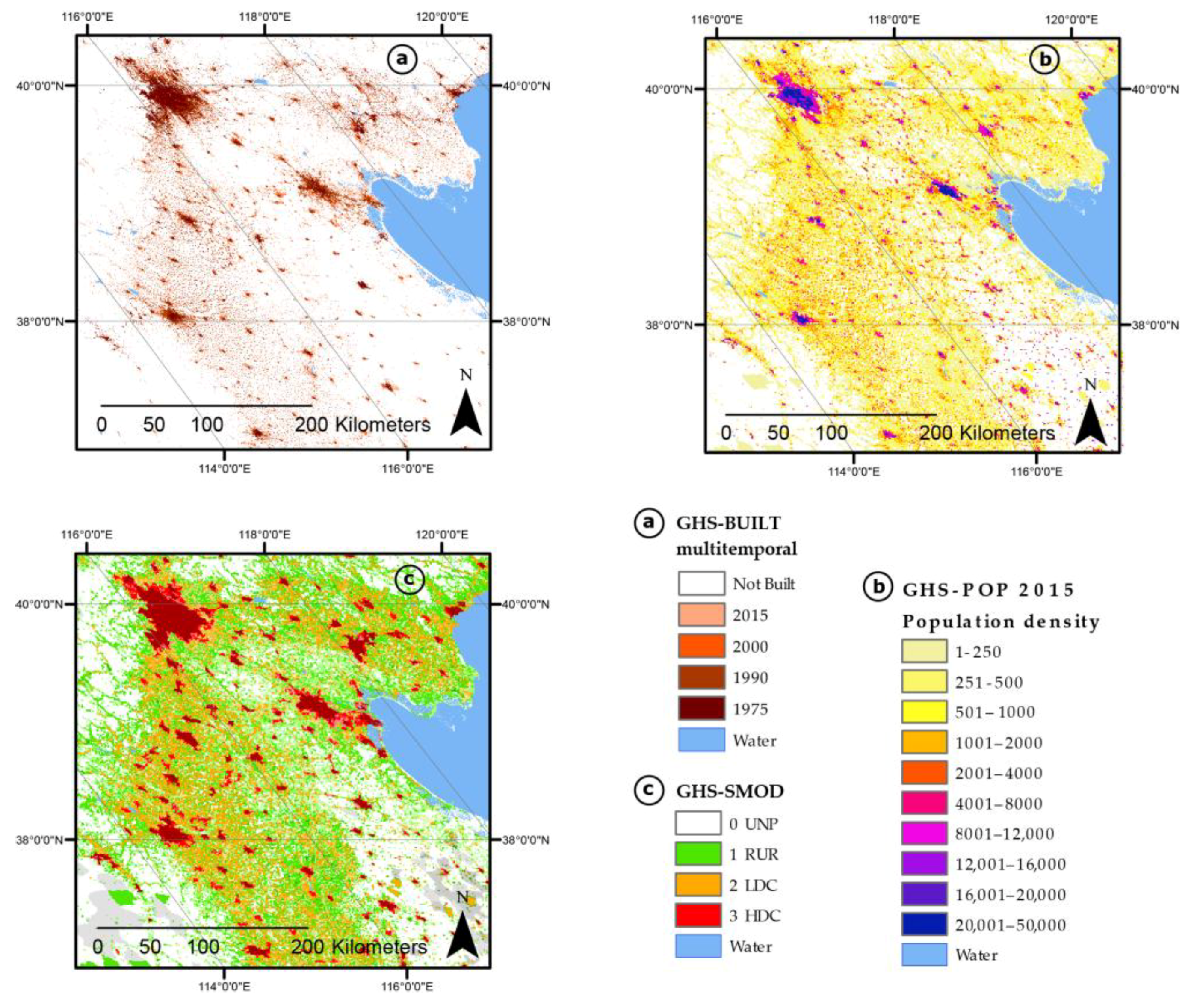
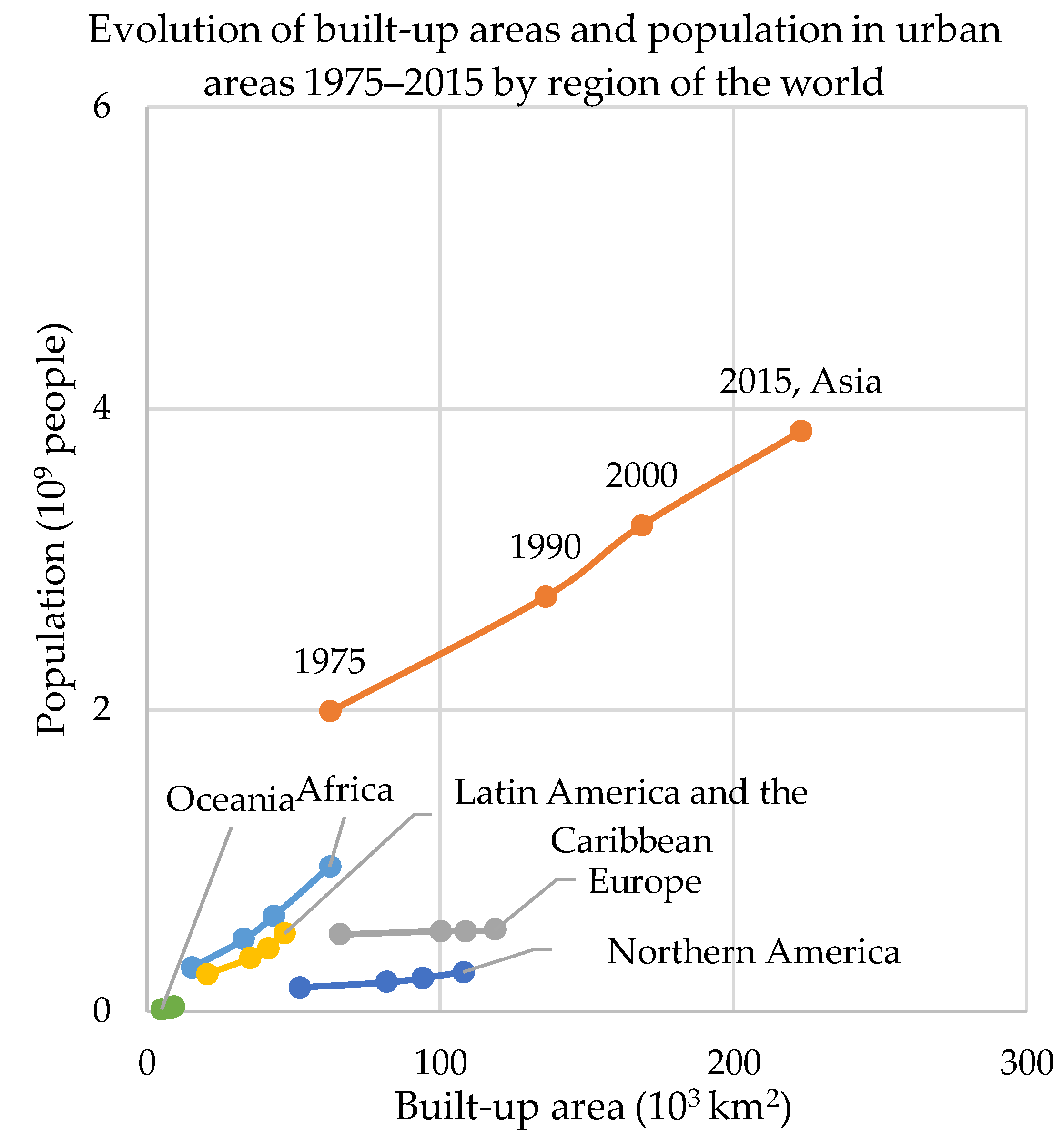
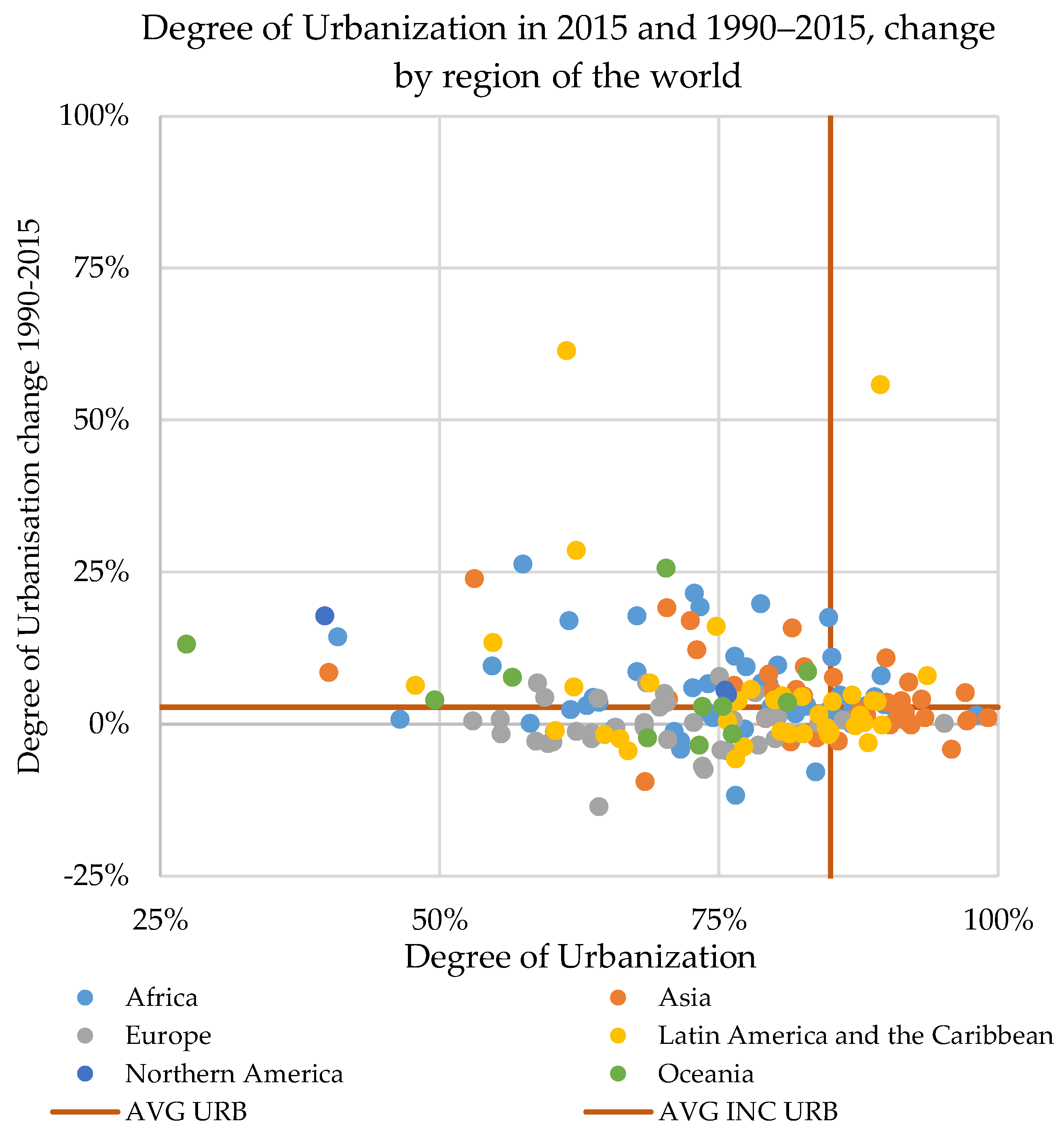
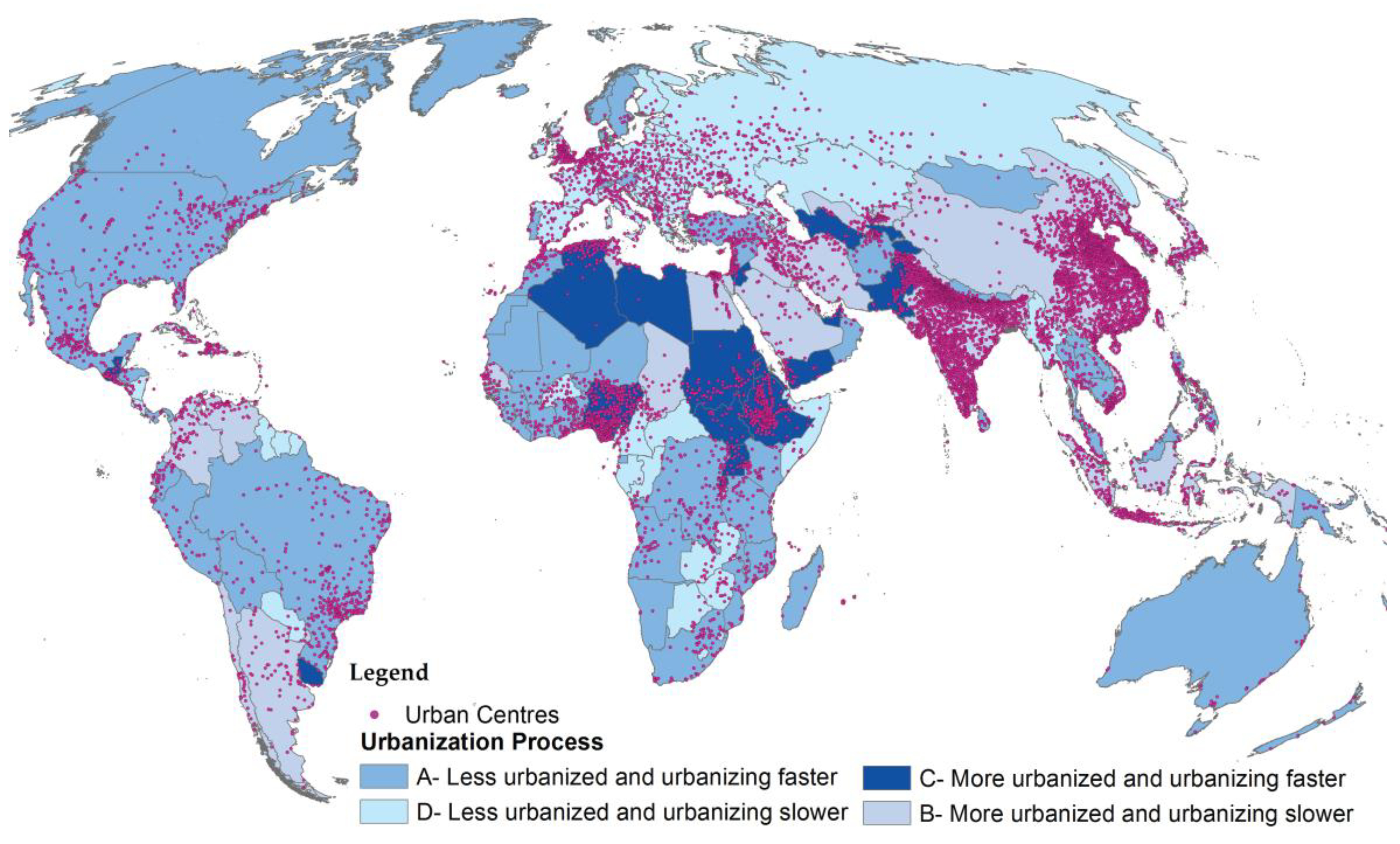
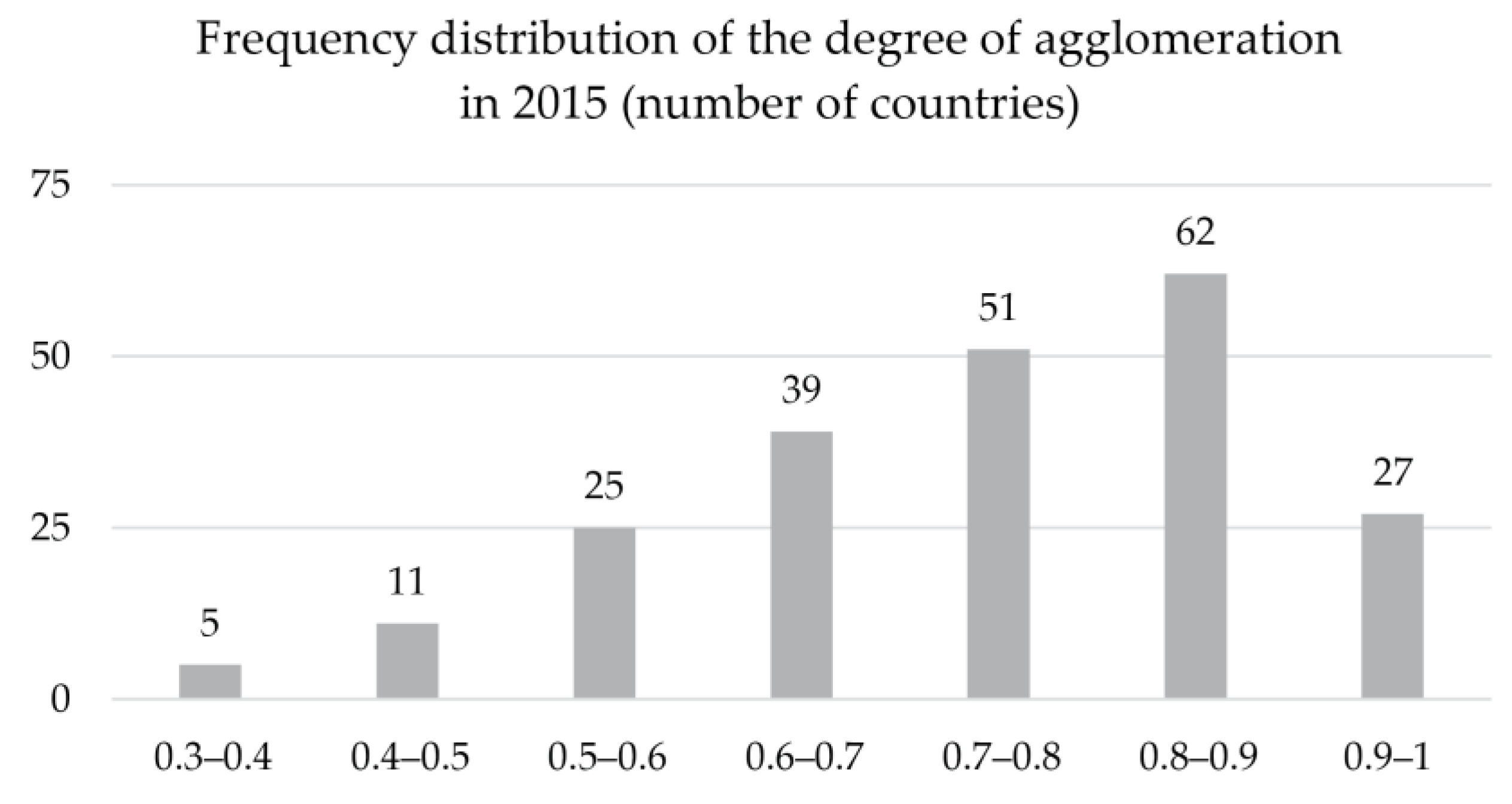
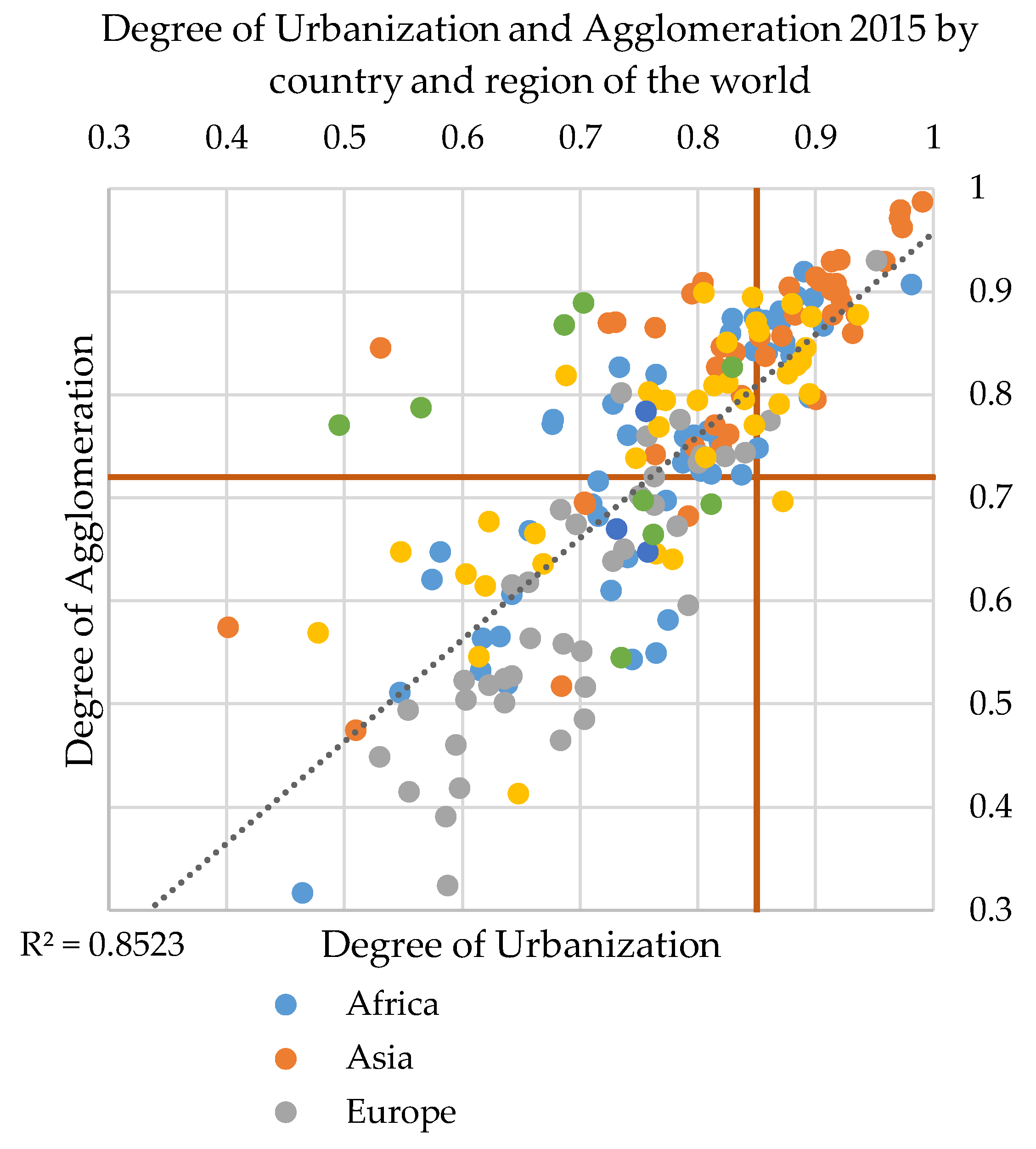
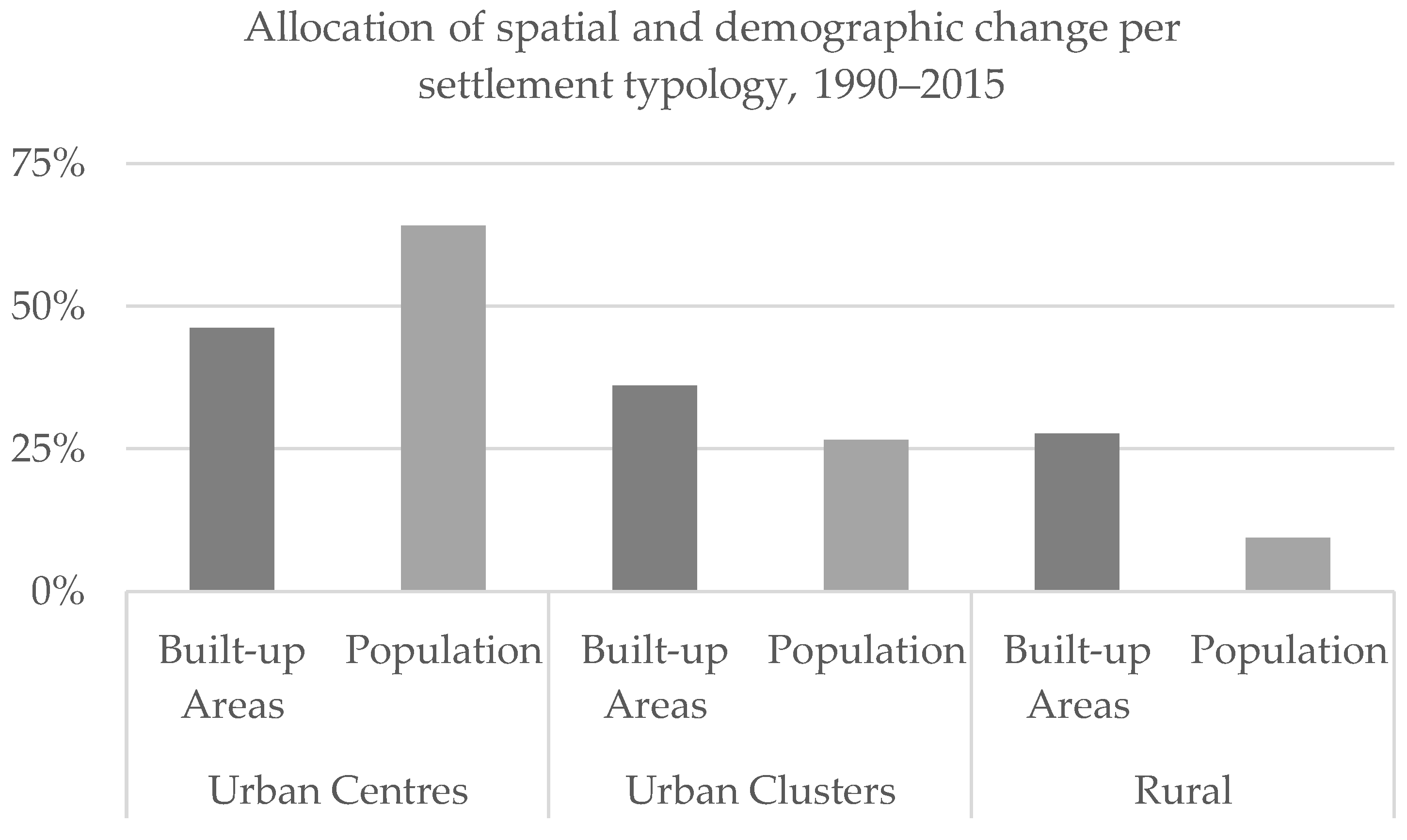
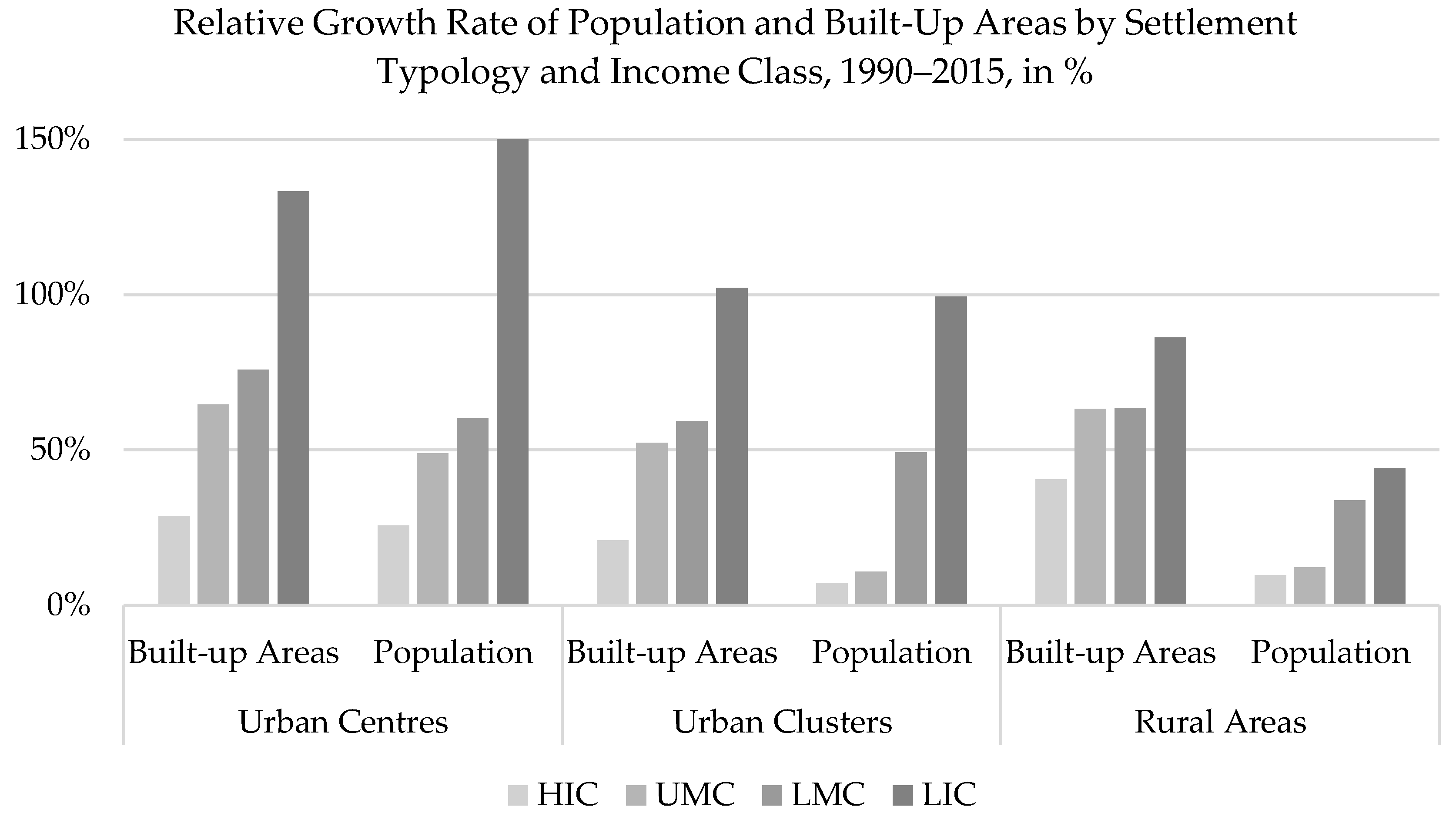
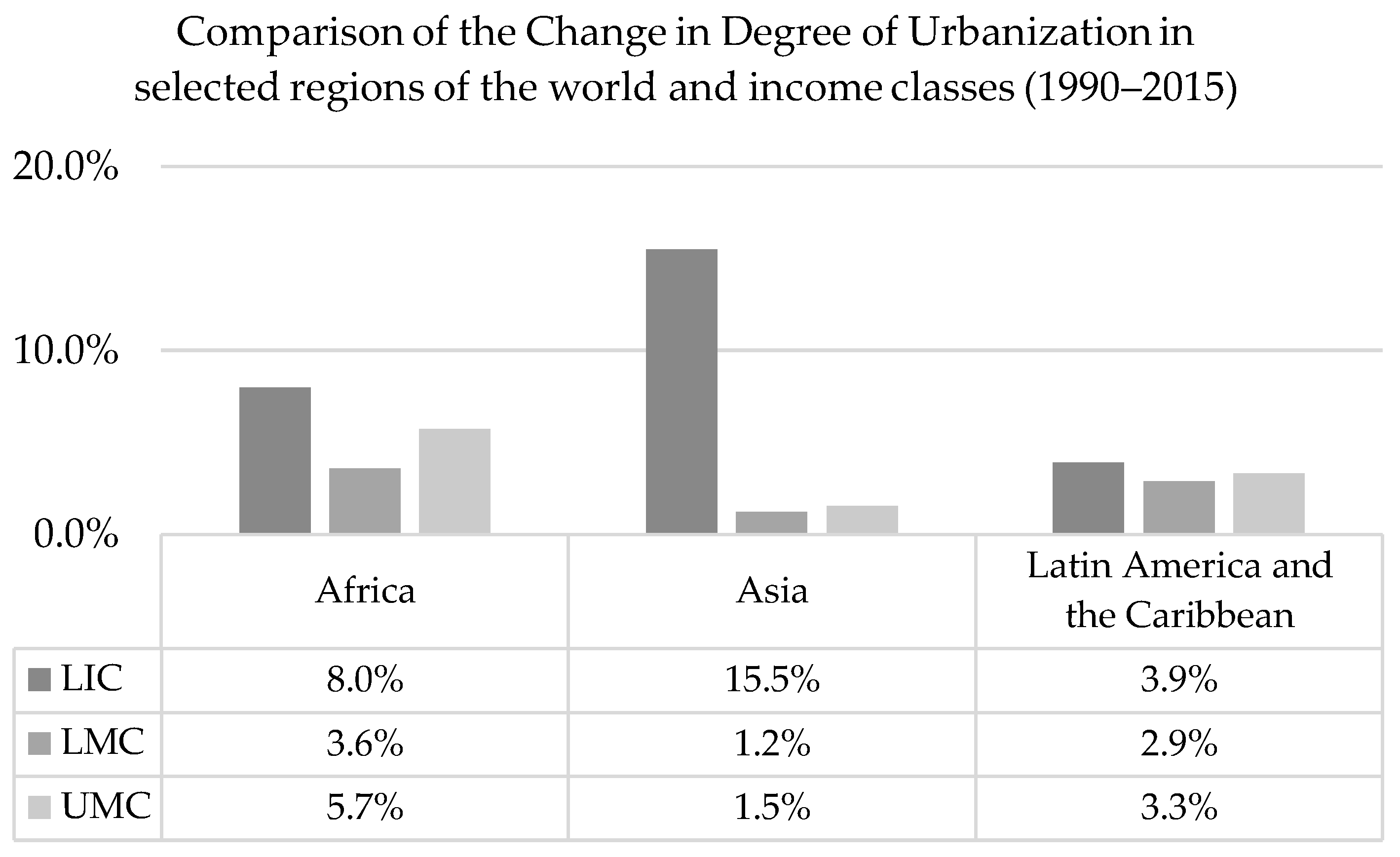
| ID | Semantic | Grid Resolution | Epoch 1 | Main Input Data |
|---|---|---|---|---|
| GHS-BUILT | Density of built-up area per grid cell | 38-m, 250-m, 1-km | 2015, 2000, 1990, 1975 | Satellite imagery |
| GHS-POP | Population counts per grid cell | 250-m, 1-km | Census data, GHS-BUILT | |
| GHS-SMOD | Classification of each grid cell into one of the Settlement Model classes: high density cluster, low density cluster, and rural cells | 1-km | GHS-BUILT, GHS-POP |
| Degree of Urbanization | GHSL | Criteria | |
|---|---|---|---|
| Grid Model | SMOD Class | Population Threshold (People) | Population Density (People/km2) |
| Urban Centre | High-Density Cluster (HDC) | 50,000 | 1500 |
| Urban Cluster | Low-Density Cluster (LDC) | 5000 | 300 |
| Rural Areas | Rural Area (RUR) | 1 | <5000 |
| N/A | Unpopulated (UNP) | 0 | 0 |
| Built-Up Area (103 km2) | Population (106 People) | |||||||
|---|---|---|---|---|---|---|---|---|
| Region | 1975 | 1990 | 2000 | 2015 | 1975 | 1990 | 2000 | 2015 |
| Africa | 15 | 33 | 43 | 62 | 292 | 478 | 635 | 962 |
| Asia | 62 | 136 | 169 | 223 | 1989 | 2753 | 3225 | 3850 |
| Europe | 66 | 100 | 109 | 119 | 511 | 533 | 533 | 541 |
| Latin America & Caribbean | 20 | 35 | 41 | 47 | 248 | 353 | 421 | 517 |
| Northern America | 52 | 82 | 94 | 108 | 160 | 193 | 222 | 262 |
| Oceania | 5 | 7 | 8 | 9 | 15 | 19 | 22 | 30 |
| Global | 221 | 393 | 464 | 568 | 3215 | 4329 | 5058 | 6162 |
© 2018 by the authors. Licensee MDPI, Basel, Switzerland. This article is an open access article distributed under the terms and conditions of the Creative Commons Attribution (CC BY) license (http://creativecommons.org/licenses/by/4.0/).
Share and Cite
Melchiorri, M.; Florczyk, A.J.; Freire, S.; Schiavina, M.; Pesaresi, M.; Kemper, T. Unveiling 25 Years of Planetary Urbanization with Remote Sensing: Perspectives from the Global Human Settlement Layer. Remote Sens. 2018, 10, 768. https://doi.org/10.3390/rs10050768
Melchiorri M, Florczyk AJ, Freire S, Schiavina M, Pesaresi M, Kemper T. Unveiling 25 Years of Planetary Urbanization with Remote Sensing: Perspectives from the Global Human Settlement Layer. Remote Sensing. 2018; 10(5):768. https://doi.org/10.3390/rs10050768
Chicago/Turabian StyleMelchiorri, Michele, Aneta J. Florczyk, Sergio Freire, Marcello Schiavina, Martino Pesaresi, and Thomas Kemper. 2018. "Unveiling 25 Years of Planetary Urbanization with Remote Sensing: Perspectives from the Global Human Settlement Layer" Remote Sensing 10, no. 5: 768. https://doi.org/10.3390/rs10050768
APA StyleMelchiorri, M., Florczyk, A. J., Freire, S., Schiavina, M., Pesaresi, M., & Kemper, T. (2018). Unveiling 25 Years of Planetary Urbanization with Remote Sensing: Perspectives from the Global Human Settlement Layer. Remote Sensing, 10(5), 768. https://doi.org/10.3390/rs10050768




